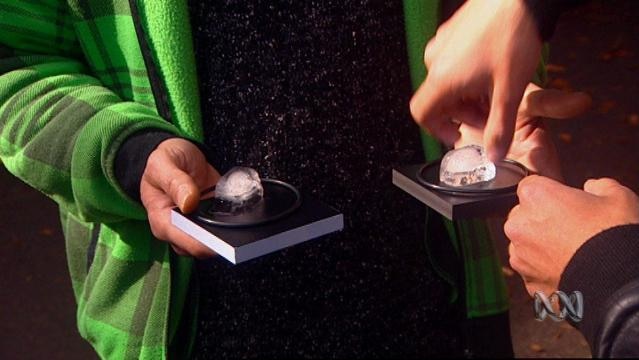DR DEREK MULLER:
When you touch an object and it feels warm or cold, what is that really telling you about the object? Here, I have a metal hard drive and a book and I'm going to ask people to compare their temperatures. Which one do you think will feel warmer — the book or the hard drive?
WOMAN 1:
The temperatures?
DR DEREK MULLER:
Yeah, tell me if one is hotter or colder or if they're the same temperature. How do they feel?
MAN 1:
This is slightly cooler than this one.
WOMAN 2:
Oh, that's warmer.
MAN 2:
Yeah, agreed.
MAN 3:
I'd say the hard drive is a lot colder than the book. 'Cause the book's got more knowledge.
DR DEREK MULLER:
Why do you think that is?
WOMAN 3:
Metal's normally a little bit chillier if you leave it in a colder temperature.
DR DEREK MULLER:
What if I said they're both the same temperature? What would you say?
MAN 2:
I'd tell you you're lying.
WOMAN 3:
I'd think you were lying, yeah.
DR DEREK MULLER:
Well, maybe the way I can prove it is I have an infrared thermometer. What do you think we're going to see?
MAN 3:
I think science might be able to answer that. And I'm not a scientist!
DR DEREK MULLER:
Make a prediction for me.
MAN 1:
I still think that's colder.
DR DEREK MULLER:
Would you bet me money?
MAN 1:
I don't have any cash.
DR DEREK MULLER:
Let's measure the temperature of the book. What do you see?
WOMAN 3:
19.0.
DR
DEREK MULLER:
OK. Now measure the temperature of that.
WOMAN 3:
19.0. Alright, well, now, I believe you.
MAN 4:
I'm trying to figure it out, actually. Trying to figure out why'd they be the same temperature. They don't feel the same temperature, though.
DR DEREK MULLER:
So, why does that feel colder if they're the same?
MAN 2:
Good one. You know the answer?
DR DEREK MULLER:
I'm coming to you guys for answers.
WOMAN 4:
We're creatives, not intellectuals.
DR DEREK MULLER:
Create an answer for me!
WOMAN 1:
I'm not a scientist! Come on, you tell me.
DR DEREK MULLER:
I'll try to answer that question with another little experiment. Here is an aluminium block.
WOMAN 1:
Ooh! Nice and cold.
DR DEREK MULLER:
And a plastic block. How do their temperatures compare?
WOMAN 1:
Completely different.
MAN 2:
Aluminium's going to be much colder.
DR DEREK MULLER:
Yeah?
MAN 4:
This actually feels colder.
DR DEREK MULLER:
Let's take this to the next level. I'll put an ice cube on both plates. What will we see?
WOMAN 3:
I'm guessing it would stay solid on this one and melt on this one.
DR DEREK MULLER:
So it's going to melt on the plastic but stay solid on the aluminium?
WOMAN 3:
Yes, but maybe I'm wrong.
DR DEREK MULLER:
That one will melt more quickly than on the aluminium.
WOMAN 1:
You'd think so.
MAN 4:
Yeah, 'cause it's cold.
WOMAN 4:
I think they're the same.
DR DEREK MULLER:
We put an ice cube on each of those. What do you see?
MAN 3:
It's melting quicker on the aluminium.
00:02:20:20MAN 4:
My God, it's melting!
WOMAN 5:
This is melting quicker than that one, even though this is aluminium and that's plastic.
DR DEREK MULLER:
So which one felt colder?
MAN 1:
This one.
DR DEREK MULLER:
How does that make sense?
MAN 1:
No idea.
MAN 3:
Could aluminium be bad for the environment?
DR DEREK MULLER:
How would aluminium be bad for the environment?
MAN 3:
It's thawing the ice quicker, isn't it?
DR DEREK MULLER:
You want the answer?
00:02:39:15
WOMAN 1:
Yes, please!
DR DEREK MULLER:
It's about thermoconductivity — the rate at which heat is transferred from one object to another. So when you felt these blocks originally, I know this one felt a lot colder. But you know from the other example we did, that they must both be the same temperature.
MAN 1:
True.
DR DEREK MULLER:
They've both been outside for a while. We see the aluminium block is melting the ice faster than the plastic block because it's conducting the heat to the ice cube faster. With the plastic block, it's a worse thermoconductor. So, heat is being transferred less quickly to this ice block and so it's staying iced.
WOMAN 3:
OK. I believe you.
DR DEREK MULLER:
Make sense?
WOMAN 5:
Yes. Definitely.
DR DEREK MULLER:
In our first example, the hard drive felt colder, even though it was at the same temperature as the book. That's because the aluminium conducts heat away from your hand faster than the book conducts heat away from your hand.
MAN 3:
Sure. That seems logical.
DR DEREK MULLER:
Which makes the hard drive feel colder and the book feel warmer. So when you touch something, you don't actually feel temperature. You feel the rate at which heat is conducted, either towards or away from you. Think about this next time you hop out of the shower in winter. It's much nicer to stand on the bath mat than on a towel beside it. Not because the bath mat is warmer but because it conducts heat less quickly away from you.
